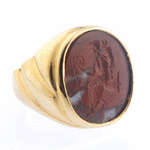Jasper Intaglio Depicting the Goddess Fortuna, 18th Century CE
Jasper/Gold
FJ.5977
The art of glyptics, or carving on colored precious stones, is probably one of the oldest known to humanity. Intaglios, gems with an incised design, were made as early as...
The art of glyptics, or carving on colored precious stones, is probably one of the oldest known to humanity. Intaglios, gems with an incised design, were made as early as the fourth and third millennia B.C. in Mesopotamia and the Aegean Islands. They display a virtuosity of execution that suggests an old and stable tradition rooted in the earliest centuries. The tools required for carving gems were simple: wheel with a belt-drive and a set of drills. Abrasives were necessary since the minerals were too hard for a metal edge. A special difficulty of engraving intaglios, aside from their miniature size, was that the master had to work with a mirror image in mind. The depiction of goddesses, particularly those of love and fortune, were special favorites of the 18th Century aristocracy. Here we see the goddess Fortuna, one of the most popular of ancient deities. She is portrayed with the cornucopia (horn of plenty), and a rudder to symbolize that she steers the course of people's lives. On this beautiful intaglio she also appears to be seated on a cornucopia, bringing even more bounty. In the Imperial period each Roman emperor had his own Fortuna. To own this ring is to possess one's own personal Fortuna; a lovely woman devoted to bringing happiness and prosperity.



